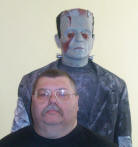

Confessions of a Junk-Movie Junkie
 “Hi,
my name is Unimonster, and I’m a junk-movie Junkie.”
“Hi,
my name is Unimonster, and I’m a junk-movie Junkie.”
As most of my faithful readers have no doubt realized by now, the Unimonster’s taste in film is, to say the least, unique. If given the choice between the latest Hollywood blockbuster and a forty-year-old made-for-TV crapfest starring Bradford Dillman and eight people whom you’ve never heard of, well, then it’s “hello Bradford.” Of the last twenty Best Picture Oscar winners, I’ve seen exactly … two. When good friend and fellow MST3K fanatic Sheila (aka Mombie) sends me a movie guaranteed to inspire severe ‘movie-pain,’ I watch it, laugh, and respond with the adventures of Bestoink Dooley in Legend of Blood Mountain. From Ed Wood to Coleman Francis, I actively seek out the auteurs of the craptastic, the masters of muddy lighting and unsynched sound. I love the “Junk” movie, in all its glorious ineptitude.
Now, when I talk about “junk” movies, I’m not talking bad movies per se, those movies that simply are unentertaining. Gigli, Ishtar, Waterworld, Hudson Hawk, The Adventures of Pluto Nash … there’s no room for these movies in the Unimonster’s library. These movies are bad in a way that Bride of the Monster or Last Train to Mundo Fine (aka Red Zone Cuba) could never be. The former films had everything going for them—budgets, star power, massive Hollywood hype—and still failed miserably. Wood, Francis, Larry Crane, Ray Dennis Steckler—none had these types of resources in their corner, but each poured their hearts and souls into their movies, and each invested their films with an individualistic style that is as recognizable to their fans as a trademark stamp.
Junk movies are a different breed entirely. A movie may be junk, but that doesn’t preclude it being a fun, entertaining motion picture experience. “Junk,” as a descriptor, refers not so much to quality as to production values, never a reliable predictor of how much I will enjoy a movie. Most of my favorite movies are “junk”—from the giant bug movies of the 1950s to Dave Friedman’s Sexploitation films of the ‘60s and ‘70s, right through to the gloriously gross-out films of Lloyd Kaufman’s Troma. Personally, I find these movies to be some of the most enjoyable I know—The Deadly Mantis is, in my humble opinion, one of the best examples of a stellar year for genre film, while movies such as Starlet, Thar She Blows, and Trader Hornee helped make the sex film socially acceptable and, whether for good or bad, led to the mainstreaming of hardcore titles such as Deep Throat and Behind the Green Door.
As a point of fact, two of the most significant films of the last half-century of Horror are Junk movies. Both were produced by neophyte directors, on shoestring budgets, with a cast of unknowns, and independently distributed. Neither was the recipient of critical praise, yet both would soon be recognized as seminal films in the Horror genre, having redefined what it meant to be a “Horror Film.” Of course, these are George Romero’s Night of the Living Dead and Tobe Hooper’s The Texas Chainsaw Massacre.
Most Junk films don’t approach that level of significance, of course. Most simply do their job as efficiently and cheaply as possible, and the quality of the movie in a secondary consideration. Most of the films produced by William Castle fall into this category, as do the movies of American-International Pictures. Indeed, Jim Nicholson and Sam Arkoff’s AIP raised the Junk movie to an art form, turning out hit movies for two decades. They displayed tremendous adaptability, first by creating films targeted at the fastest growing demographic of the 1950s, the teen-ager; then by always managing to identify the trends that their target audience would want to see on the screen. From the Sci-Fi / Horrors of the 1950s, to the Beach Party craze of the ‘60s, to the Exploitation films of the ‘70s, AIP stayed on top of the game by giving their audiences exactly what they were expecting—the cinematic equivalent of a burger with everything; in short, junk food for the movie-lover’s soul.
But if AIP was the class of the junk-movie market, then there were a dozen or more companies hovering around the bottom of the pile. Many existed just for the length of time it took to produce one film; some barely existed at all. Producers would form ad hoc companies for the financing or distribution of a picture, companies that would cease to exist once their function in life had been performed—much like male mantises. The movies these fly-by-nights produced were occasionally good, frequently bad, and seldom memorable. They were, however, usually entertaining.
And the Junk film hasn’t gone away. If anything, it’s going stronger than ever. We don’t find them in Drive-Ins and Grindhouses any longer, but streamed directly into our televisions and our cell phones. Now, everyone can be a Junk film auteur, shooting their movies on the very same cell phones that they’ll stream the movies to the very next day. The budgets are even lower, as are the production values. The talent of those involved is often orders of magnitude below that of Steckler or Francis. But the entertainment value is still there, and I’d still rather see that, than last year’s best picture winner.
I invite you to explore the Unimonster's other Crypt, which you'll find HERE!
![]()
Creature Feature © D. Dyszel 2025
Sponsored by